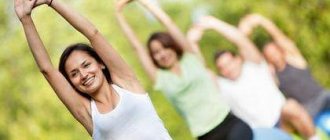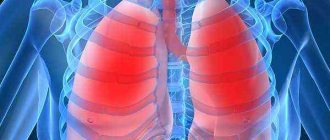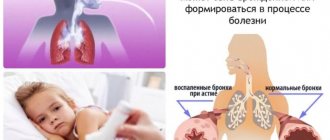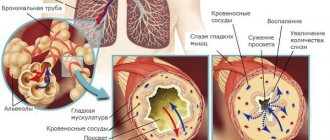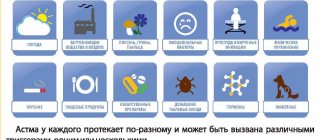Physical exercise is recommended for diseases of the respiratory organs. They help improve blood circulation, accelerate the delivery of oxygen to the bronchi, remove phlegm, and increase the overall tone of the body. Exercise therapy for asthma normalizes the amount of oxygen in all organs, teaches the patient how to control respiratory cycles, stabilizes the nervous system, helping to prevent asthma attacks. Exercise helps improve well-being and quality of life.
Objectives of exercise therapy for asthma
Exercise is part of comprehensive asthma treatment. Special exercise therapy programs are designed to achieve the following goals:
- Strengthening the muscle corset, improving overall well-being.
- Formation and regulation of the physiological rhythm of breathing, improvement of lung ventilation.
- Removal of excess air from the respiratory tract, stabilization of blood composition.
- Relaxation of the muscles involved in breathing.
- Prevention of allergic respiratory manifestations.
- Strengthening the flexibility and elasticity of the chest.
With developed chest muscles, it is easier to cope with bronchospasms. Strengthening blood vessels helps improve oxygen supply to all organs and prevent asthma attacks. Among the goals of exercise therapy for bronchial asthma are strengthening self-confidence and relieving psychosomatic causes of asthmatic reactions.
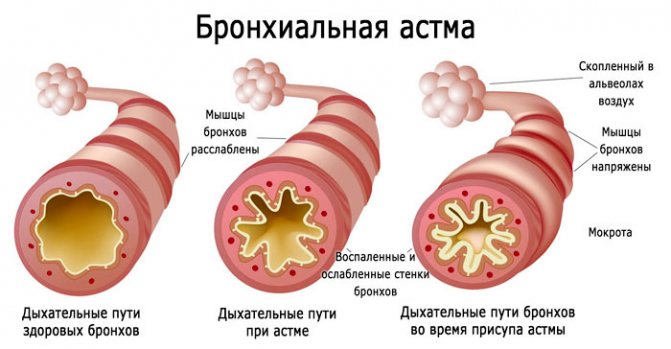
Physical exercise is indicated in the period between exacerbations of asthma; their goal is to reduce the number and severity of attacks. Among the contraindications to exercise:
- regular attacks of suffocation;
- acute conditions with inflammation and temperature above 38°;
- bleeding or the risk of bleeding;
- malignant neoplasms;
- cardiac and respiratory failure (pulse - above 120, breathing - more than 25 per minute).
Exercises are performed regularly, interrupted only when the condition worsens. The exercise therapy complex for bronchial asthma includes breathing exercises, which can be done in any condition, as well as sound exercises, which train the ligaments as part of the respiratory organs.
Buteyko method
Some types of exercise initially cause the patient to feel worse, after which he quickly recovers. Such methods of breathing exercises include the one developed by Konstantin Pavlovich Buteyko. It is aimed at increasing the amount of carbon dioxide in the lungs. It is best to master the system under the supervision of specialists. The simplest exercises from it are:
- Hold your breath for a while. Then breathe shallowly and shallowly for as long as possible so that the state of lack of air remains. As soon as you feel that you urgently need to exhale, start the exercise over again.
- Hold your nose and walk around your room or take a walk in the park. Stop and try to regain your breathing. As soon as you start breathing calmly, start doing the exercise again.
- The third exercise is shallow breathing, in which try not to strain your lungs. It is carried out as if by other parts of the body. At first you need to breathe in this way for at least 3 minutes, after a certain amount of training you need to increase the time to 10. It is best to increase the duration of the exercise gradually.
This system can be used by people of any age. Do not change the sequence of exercises for gymnastics to be effective.
Mechanism of action of exercise therapy
Illness and difficulty breathing weaken the body. This further harms breathing, as the lack of strong muscles and weak blood vessels impair the supply of oxygen.
A specially selected set of exercise therapy exercises for bronchial asthma strengthens the muscles of the back, chest, and diaphragm. Due to this, the elasticity of the muscles of the chest, abdominal muscles and lung capacity increases.
Breathing exercises affect the bronchi - accelerate blood circulation and metabolic processes. Due to this, swelling is reduced, fluid outflow is improved, and mucous secretions leave the bronchi faster. The gaps between the bronchioles become wider, allowing more oxygen to enter the lungs. The breathing rate returns to normal.
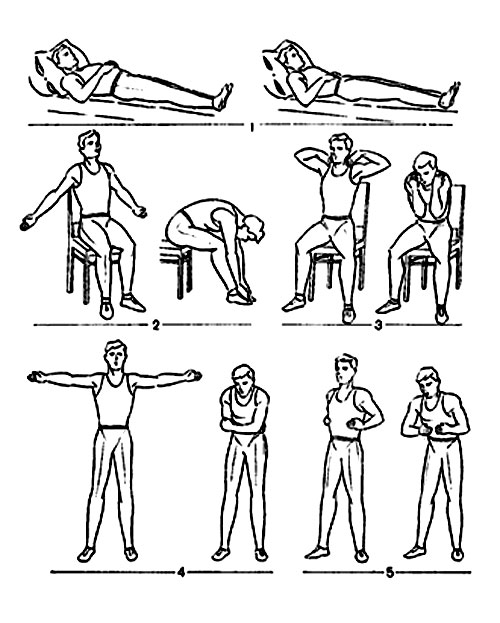
The sound part of the gymnastics strengthens other parts of the muscular complex of the respiratory system. Vibrations of the vocal cords are transmitted to the respiratory apparatus and pectoral muscles, which stimulates ventilation of the alveoli and trains breathing.
For information: from a large set of exercises, a complex is compiled for each patient, which takes into account physical capabilities, characteristics of the course of asthma, frequency of attacks, and age.
An increase in physical activity leads to the release of adrenaline, the tone of the muscles of the whole body rises, and the mood improves. During exercise therapy, the patient acquires diaphragmatic breathing skills, learns to control attacks, and gains self-confidence.
Strelnikova training
Gymnastics is simple and accessible to the trainee. No special equipment or dedicated space is required, and there are no age restrictions.
Strelnikova’s complex affects both the lungs and bronchi, and the entire body. This technique can be used for all kinds of diseases, but the pathology of the pulmonary system comes first. It is important for patients to learn how to cope with asthma attacks on their own. A set of techniques, with small but strong inhalations through the nasal cavity and passive exhalation, will help stop the oncoming attack, the ability to recover from bronchitis and solve sinus problems. Thanks to the inhalations performed during bending and squats, the abdominal muscles and diaphragm are tensed, while the lungs are straightened and filled with air. In patients, problems are observed during exhalation, which depends on the quality of inhalation.
You should try to perform all exercises rhythmically and adhere to execution techniques. The number of repetitions is a multiple of four. Classes are held regularly, at least 2 times a day for thirty minutes. Breathing exercises will help prevent an attack if you apply the techniques at the first sign.
Execution Rules
At the initial stages, classes are recommended to be carried out in the presence of a physical therapy specialist. After all the rules have been learned, you can move on to independent training. A set of exercise therapy exercises for asthma can be supplemented and changed towards increasing loads as the muscles strengthen.
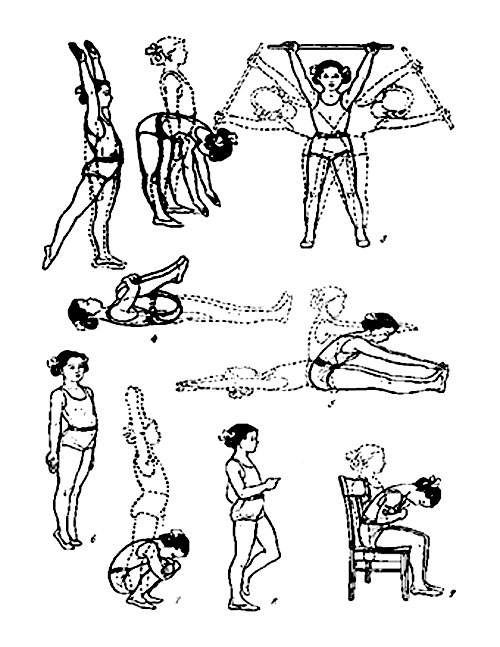
When studying independently, you should adhere to the following rules:
- Classes are conducted in a well-ventilated room with an open window or vent. Outdoor activities are recommended.
- During exacerbations, classes are not carried out (breathing more often than 25).
- If the condition worsens, exercise therapy is stopped.
- Exercises are performed regularly; if you feel unwell, bronchodilators are taken before exercise on the advice of a doctor.
- In addition to exercise therapy, swimming and walking in the fresh air are useful, preferably in a park area.
When practicing independently without the supervision of a doctor, the patient’s capabilities and level of physical development are first checked in order to choose the right load.
Expected Result
Regular breathing exercises lead to a number of positive effects:
- the body is better saturated with oxygen;
- the disease progresses more easily - attacks become less frequent, remission lasts longer;
- intoxication decreases;
- sputum discharge improves;
- muscle tone is strengthened;
- pulmonary volume increases;
- the removal of toxins improves;
- immunity is activated;
- the likelihood of developing status asthmaticus, a dangerous complication of the disease that can lead to death, is reduced;
- blood circulation improves.
Modern medicine confirms the benefits of breathing exercises in the treatment of many ailments. This type of gymnastics has few contraindications and is suitable for adults and children. If the technique is followed, it can delay the onset of an attack and alleviate the symptoms of the disease.
Set of exercises
The initial stage of training prepares the patient for more intense loads, which will need to be constantly increased as the muscle corset is ready and strengthened.
For the first 5-7 days, breathing exercises are performed, which teaches you to control your breathing.

Exercises in a sitting position:
- The pose is free, the back is straight. Inhale through your nose, exhale longer through your mouth. Multiplicity – 4-8 times.
- While inhaling, raise one hand up, hold your breath for 1-2 seconds, exhale long - lower your hand. Repeat - other hand up. Number of repetitions – 4-8.
- While sitting on a chair, simultaneously bend your feet and hands at the joints. Perform 10-12 times.
- Inhale through your nose, hold your breath for 1-2 seconds, exhale long. Multiplicity – 6-8 times.
The main set of exercise therapy exercises for asthma, standing:
- When inhaling, the hands are fixed under the arms. As you exhale, lift up and lower. 6-8 repetitions.
- As you inhale, raise your arms up, and as you exhale, tilt your body to the left along with your arms. Return to the starting position, repeat in the other direction. 6-8 reps.
- Inhale through the nose, as you exhale, tilt the body to the right, the hand moves down the leg. Return to original position. Repeat - left. 6-8 times.
- As you inhale, turn your body to the left while simultaneously spreading your arms to the sides, palms up. As you exhale, return to the starting position. 6-8 repetitions.
- As you exhale, bend the leg at the knee and raise it to the chest; while inhaling, lower it and stand straight. 6-8 times.
Exercise therapy exercises are accompanied by breathing and sound exercises. Several types of breathing practices have been developed - the Strelnikova, Butenko method, which improve lung ventilation and relieve bronchospasm. Many people choose breathing exercises from yoga.
A massage or simple chest rubbing can help warm up your muscles before exercise. Rules for conducting breathing exercises:
- do not perform in the cold;
- holding your breath for no more than 5-7 seconds;
- Do not increase the load recommended by your doctor.
The result of breathing exercises should not be suffocation or difficulty breathing.
Note: it is better to exercise before lunch, when fatigue has not yet accumulated.
Preparation for classes
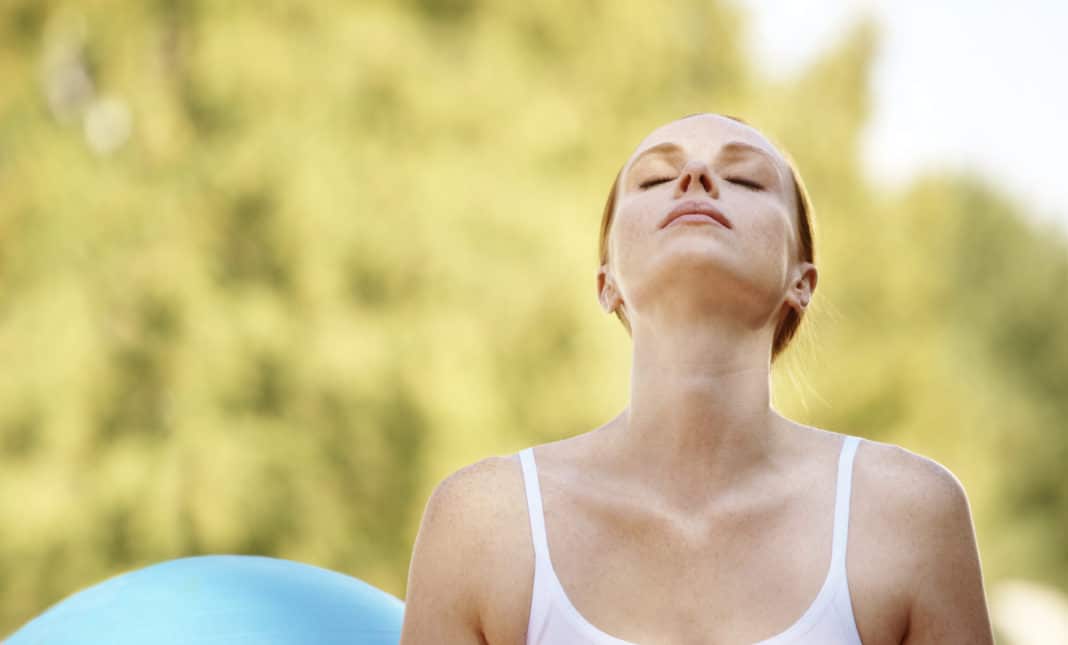
For greater effectiveness from exercises, it is necessary to prepare the body:
- Sitting on a comfortable chair with your back straight and your hands on your knees, you need to relax.
- For ten minutes, perform shallow, shallow nasal breathing.
When carrying out these actions, you may experience a feeling of lack of oxygen and dizziness. However, this allows you to maximally free the pulmonary system from air masses, which has a positive effect on the effectiveness of the actual exercise itself.
Features of breathing exercises for children
Breathing exercises are beneficial for all children, but a child with asthma needs them. From childhood, it is useful to strengthen the skills of proper breathing, which will not only ease the course of asthma, but also help to speak correctly.
Attention! Physical therapy exercises for bronchial asthma are performed from 3 years of age.
Together with breathing and sound exercises, they help strengthen the muscles of the chest and respiratory tract. It takes the little ones more than a month to fully master the complex.
Main features of classes with children:
- The child needs to be explained why the exercises are being done, and it needs to be fixed in his mind that he feels better after the exercises.
- Conduct classes at a convenient time, when he is not tired, does not want to eat or sleep.
- Come up with interesting names for the exercises, captivating the child with the game.
- Make sure that while performing, he does not move his shoulders, body, strain unnecessary muscles, or puff out his cheeks.
- Teach the correct method of speech breathing - short inhalation through the nose, longer exhalation through the mouth.
- The exercise is repeated 4-6 times, no more.
- Tasks need to be changed to keep the child interested.
- The exercises are easier to do with a count or with music.
- You should not do breathing exercises if you have a runny nose or general malaise.
One of the basic rules is regularity of classes; you need to find time to study every day, interrupting only during illness.
Before class, you need to prepare pieces of cotton wool, a glass of water and a straw and use them for breathing training. Useful tools will diversify your activities and make them less boring. The child, however, must understand that this is not a game, but a serious matter that will help him breathe easier.
Breathing exercises for children improve bronchial function, form nasal breathing, improve metabolic processes, calm the nervous system, and fight deformities of the spine and chest.
Useful tips
If you regularly and correctly perform gymnastic exercises, this will not only reduce the frequency and intensity of attacks, but will also have a beneficial effect on the body as a whole.
Data obtained from a survey of patients indicate that moderate physical activity:
- improve the functioning of the cardiovascular system;
- normalize healthy sleep;
- and also reduce the need to take medications.
Some people like to exercise to the accompaniment of music, but it is best to do the exercises in complete silence, so that there are no distractions and you can focus on inhaling and exhaling.
Even calm music can reduce concentration and adversely affect the performance of gymnastics.
It is not for nothing that they say that the main thing is not quantity, but quality, so try to carefully and carefully complete the entire complex.
